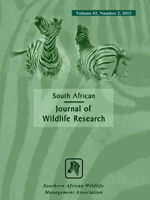Water is one of the fundamental requirements of life but there has been little study on the use of water by free-ranging wildlife communities. We investigated the timing of waterhole use by African fauna using webcams to determine whether this mode of data collection was viable, to determine whether animals drank randomly throughout the day, whether there were differences between guilds in waterhole use and finally we created a relative rank of water dependency by comparing waterhole use with the relative abundance of species at Kruger and Pilanesberg National Parks. We used webcams sited at waterholes in South Africa's Kruger and Pilanesberg, Madikwe Game Reserve and Tembe Elephant Park, and Botswana's Mashatu Game Reserve to remotely monitor waterhole use at random times throughout the day. Over the 16-month study period, 1546 observations were made of 30 species at waterholes, with elephants (Loxodonta africana) and impala (Aepyceros melampus) being the most frequently observed species. There was a high degree of diurnal overlap in waterhole use amongst the herbivores, but they partitioned the time of peak waterhole use. Large predators were largely nocturnal while their prey was invariably diurnal. The index of relative water use showed that hippopotamus (Hippopotamus amphibius), warthog (Phacochoerus africanus) and blue wildebeest (Connochaetes taurinus) were highly water-dependent, whereas lion (Panthera leo), spotted hyaena (Crocuta crocuta) and kudu (Tragelaphus strepsiceros) appear relatively water independent. African fauna may partition waterhole use to avoid competition and predation. The use of webcams is a novel technique to allow remote monitoring of aspects of the ecology of African wildlife at minimal cost.
How to translate text using browser tools
1 October 2012
Waterhole use by African Fauna
Matt W. Hayward,
Madeleine D. Hayward
ACCESS THE FULL ARTICLE
camera trap survey
Carnivora
competition potential
drinking patterns
elephant
remote observations
resource partitioning





